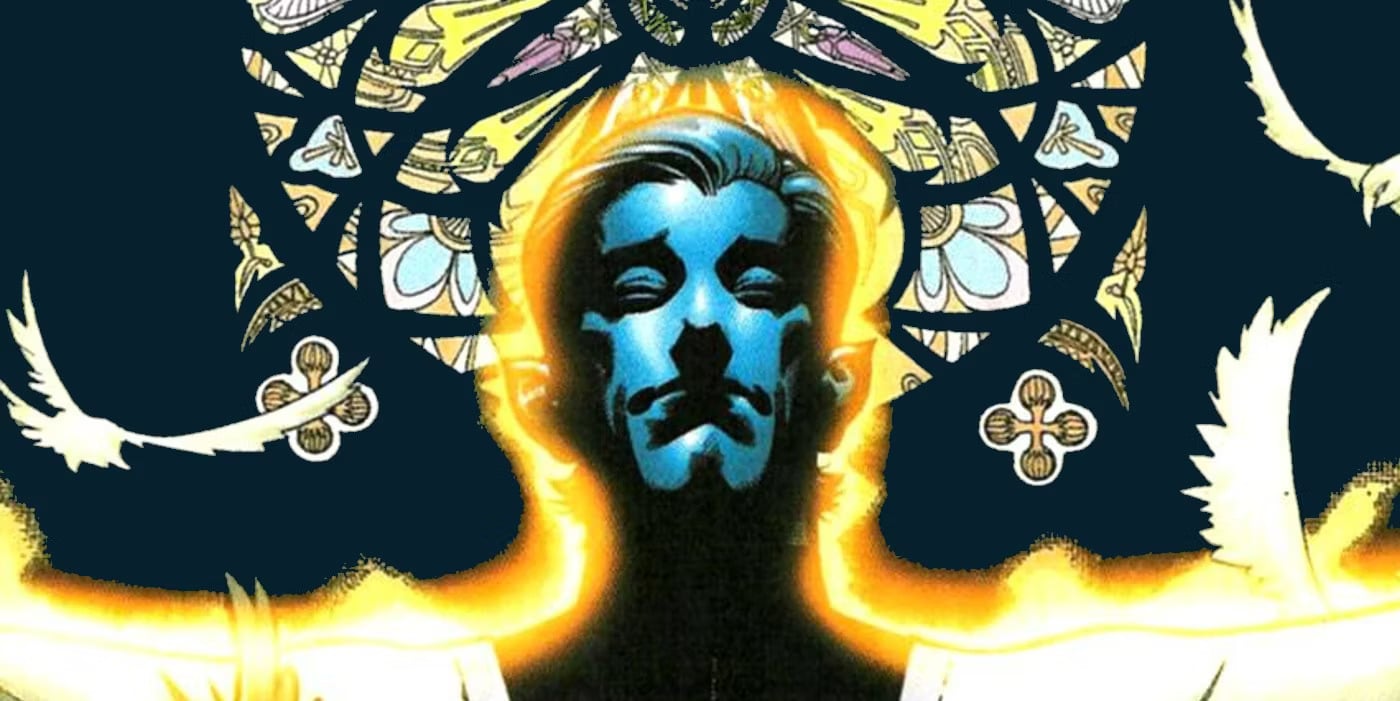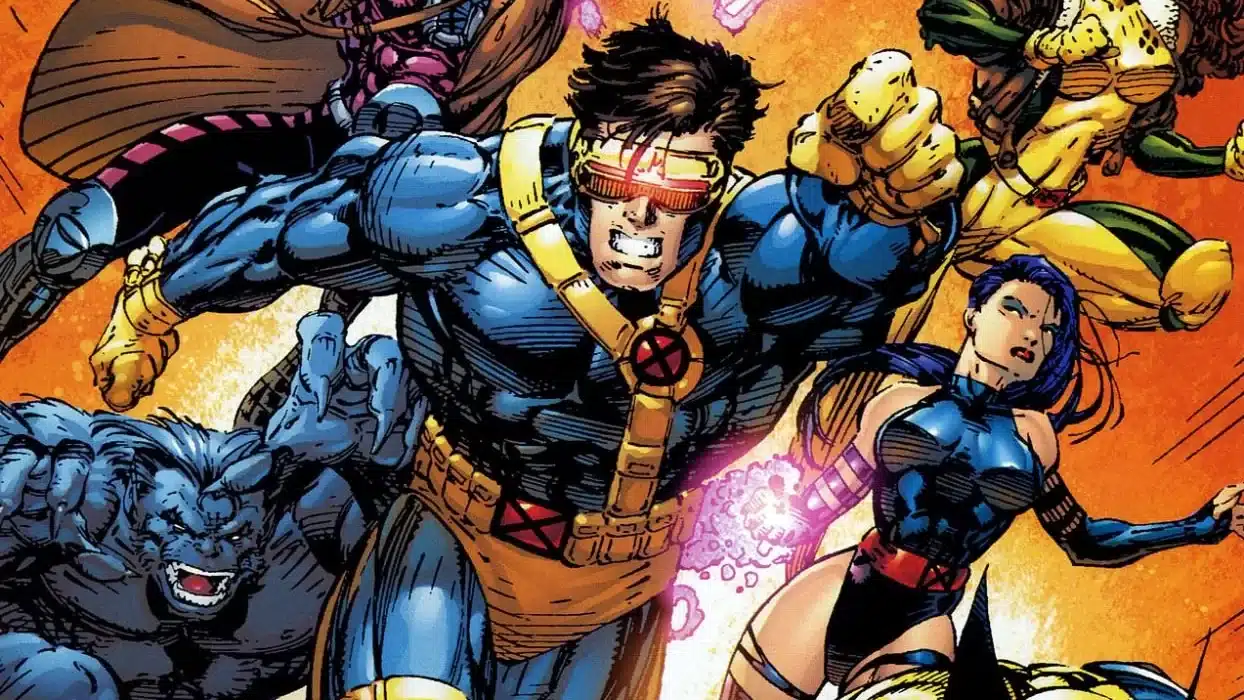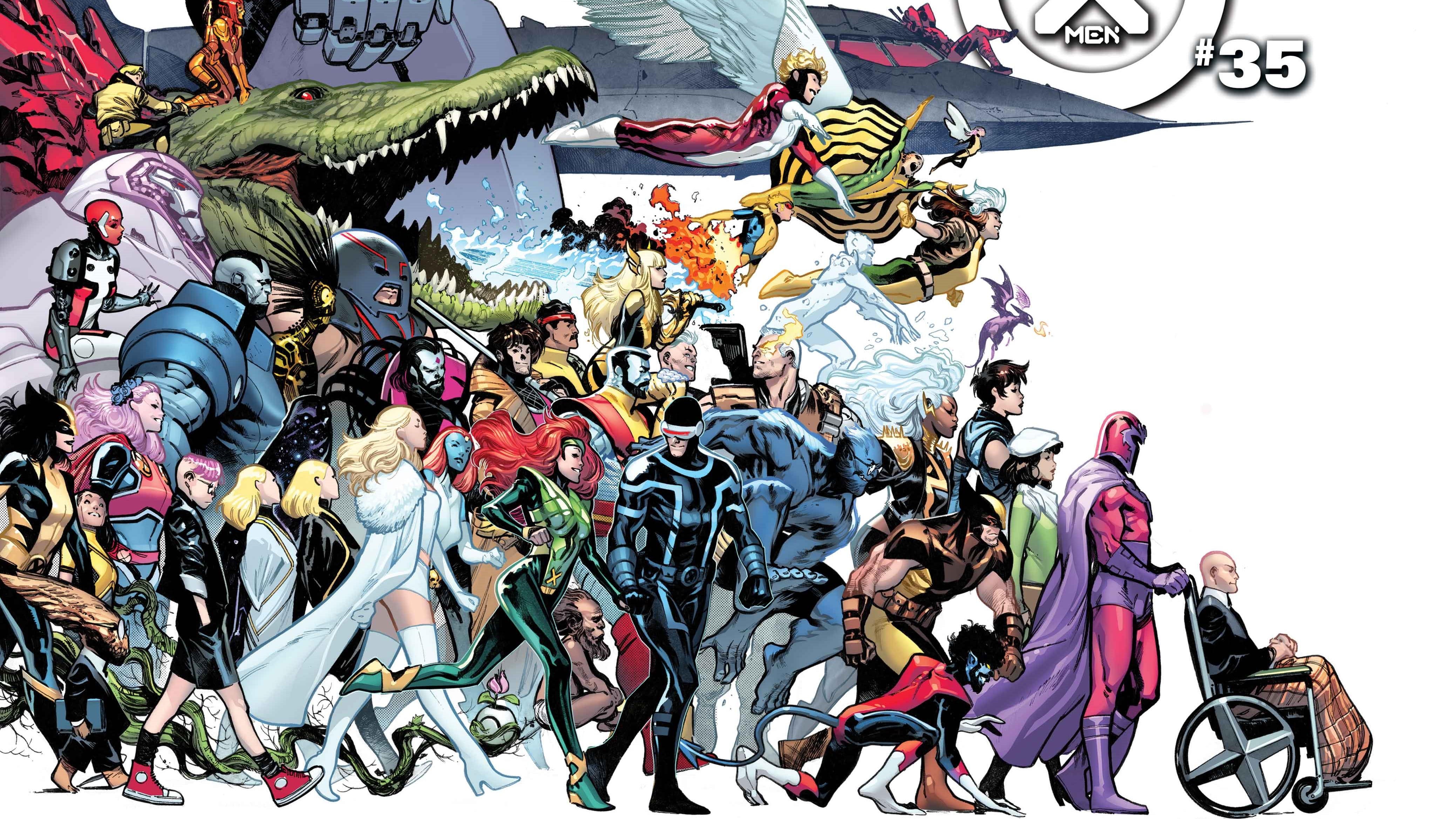Released this year from Secret Acres, The Marchenoir Library is the latest work in Alex Degen’s unusual career. Degen, an American cartoonist, has created a unique graphic novel told entirely through the front and back covers of a fictional superhero series. We are given brief descriptions of the titular Marchenoir, her recurring allies and enemies, at the front of the book, and two-sentence summaries for each cover in the book. This leaves the reader to scour each cover for more information, drawing conclusions about Marchenoir’s world only through snippets of information and the design of its characters and world. What could be a maddening reading experience is eased by Degen’s incorporation of recognizable superhero imagery and tropes, adapted to his particular style and interest. One of the most prevalent themes in Marchenoir is one familiar to X-Men fans: kink.
Take the designs of Marchenoir’s characters, which naturally incorporate fetish elements. Marchenoir herself wears a fairly standard uniform for a woman superhero, clad in a full-body pink latex suit, with pink gloves and pink high-heeled boots overtop, complete with bunny ears. Her adversaries include Lamuta, a masked Victorian noblewoman who collects people into her human menagerie, and whips them to perform tricks. There’s also the Rubber Shroud, an embodiment of crime dressed exactly as the name implies. The terrifying Wonderful Boy is meant to be a living doll, but his appearance is almost identical to a gimp suit.

Marchenoir’s adventures revolve around love and desire, as Marchenoir falls into romance after romance. She meets Columbina, a Warrior of Love, but one who is powered by patrons whose conception of love is too old-fashioned to be of any benefit to Marchenoir, and her repeated romantic entanglements often lead to trouble or further adventures. Her villains do not search for love like Marchenoir, but instead force others to love them. This includes holding humans as pets, like Lamuta, the relentless harassment of Wonderful Boy (whose desire to make Marchenoir love him almost destroys the universe), or outright mind control, employed multiple times in this collection. Marchenoir often falls into fantasization, trapped in dream worlds or alternate realities filled with pleasure. She battles clones of herself in a beauty contest, drinks the milk of paradise, and often finds herself in some sort of bondage.
The sexual themes of Marchenoir run throughout the book, giving it a distinct character without verging on being tacky. Marchenoir’s outward horniness and embracing of these fetish images and stories never feel out of place, but mesh perfectly with the superhero subject material. That is because Marchenoir front-faces themes and images that have been present in superhero comics since very near their inception, kept in the background by content standards that limited how directly superhero comics could address these ideas.
William Moulton Marston, the co-creator of Wonder Woman and bondage evangelist, incorporated bondage and submission elements into Wonder Woman’s character and early stories. Marston envisioned a character who used love to conquer her enemies, and combined female sexuality with female empowerment. Many of these themes were immediately walked back once Marston left Wonder Woman, but her influence on the industry remained.
Fans of Chris Claremont’s X-Men will find a lot of familiar material in The Marchenoir Libraries. “An aristocratic woman dressed in Victorian kink wear with a predilection for kidnapping” could refer to either Lamuta or Emma Frost. The Hellfire Club at large remains the most outward example of bondage and kink in Claremont’s X-Men, though it is far from the only example. Claremont’s tendencies have become so well known fans have openly questioned his kinks for years, and there’s even a (decidedly kink-shaming) blog dedicated to every instance of mind control in Claremont’s work. There is no doubt that Claremont was aware of the kink implications of his stories. His notes for the Hellfire Club explicitly say that “kink is allowed, but only to a point.”

Some more examples, then, for posterity: The Dark Phoenix Saga features an extended mental attack on Jean Grey, ultimately convincing her that she herself is a Victorian bondage queen. Multiple villains capture and imprison Storm to force her to become their bride, including Doctor Doom who turns her into a statue, and Dracula who fascinates her. Magneto engages in literal age play by reducing the X-Men to the mental state of children, and force-feeding them through a robot nanny. The Hellion Empath, X-Men’s perennial sexpest, both forces Firestar to fall in love with him and induces such powerful sexual urges in two side characters that when they re-emerge, they are dressed fully in fetish gear and shocked at what has become of them. Or, take the case of Rachel Grey, mentally conditioned into being a mutant-hunting hound and dressed in a red leather suit complete with spikes. After she breaks her control, Rachel continues to dress in that outfit. And late-stage Claremont only gets more explicit as the moral constraints of the 80s fall away, and he introduces elements of forced orgasm, and body modification.
Claremont’s inclusion of kink in his stories is certainly unique in its frequency and intensity, but not in its context. Superhero stories are intrinsically linked, in some ways accidentally and in some ways by creators, to kink elements. Superheroes wear masks and skintight latex, leather, rubber, or spandex suits. Superheroes have secret identities, where they keep their transgressive or illegal behavior secret, for fear how it would affect their personal lives or the lives of their loved ones. Superheroes fight and dominate their opponents, a behavior which Marston tied quite clearly to sexual domination.
These general trends are played on by Marchenoir, taking the elements of superhero stories and fetish that overlap and making them more explicitly kinky. Take Marchenoir’s usage of masks, one of its recurring motifs. Countless characters wear masks, not just limited to the book’s major, named characters. These masks aren’t just sleek domino masks, but also iron masks or theatre masks. Marchenoir’s sister, Peony, derives her power from her mask, but it also at one point takes control of her mind. The world of Marchenoir is built for these fetish elements, and they become part of the setting.

Claremont utilized the superhero setting to his advantage. The original Silver Age series already introduced multiple characters with powers of mind control or illusion, and Claremont capitalized on this trend. No other superhero series at the time had so much mental domination, and this featured frequently into his stories. Plots involving transformation, whether it be Mystique’s shapeshifting nature, Psylocke’s racial transformation, Tom and Sharon’s racial transformation, Ilyana’s sudden aging, or Polaris’ size changing all find a (somewhat) natural home in the stories of the X-Men. The built-in disposition of superhero stories towards kink combined easily with the features of the X-Men, allowing Claremont to really unleash his fantasies.
However, many of Claremont’s ideas for X-Men had to be sidelined or removed entirely due to the standards of the time. Claremont’s plans for gay and lesbian characters never panned out, and even today those plans have yet to come to fruition (the notable exception being the extremely recent textualization of Destiny and Mystique’s relationship). Instead, these ideas were limited to subtext, buried just barely beneath the surface. Marchenoir has no limitations on its content, and depicts Marchenoir as bisexual. The queer ideas and characters that underpinned Claremont’s work are brought rightly to the forefront.
Claremont’s obvious queer subtext made his work popular with generations of readers who couldn’t find any sort of representation in the other superhero comics of the time. Though prevented from becoming textual, Claremont’s depiction of marginalized identities resonated with readers. Claremont’s use of kink front-faced another kind of sexuality, one that also was largely forbidden from mass media. It solidified X-Men as the series for outcasts, deviants, or weirdos. Despite being written by a cishet white man, Claremont’s X-Men became a place where readers could see themselves, or their desires, play out on the page.

Much has been made of how superhero comics reflect the reader’s most basic power fantasy. Claremont’s X-Men, and to a lesser extent other superhero series, also represent a sexual fantasy. Comics allow readers to enjoy their fantasies, particularly those beyond human capabilities. Claremont’s X-Men gave us a sexual fantasy outside of heteronormativity, and beyond mainstream sexual tastes. With the opening of the comic industry in the decades since Claremont’s heyday, queer stories by queer writers have an easier time reaching audiences, rendering much of the queer representation in X-Men less essential. However, Claremont’s X-Men has remained relevant in queer discussions for both its historical value, as well as the still-unusual amount of kink.
In The Marchenoir Library, Marchenoir often finds herself lost in worlds of fantasy. She dreams of worlds of pleasure, of machine lovers, of a beauty contest / wrestling match against many clones of herself. Marchenoir’s fantasies are strange and enjoyable, visions of desire impossible in reality. Her fantasization stands in for the reader’s, both imagining sexual fantasies alongside the violent. Marchenoir becomes consumed by her fantasies, so enticed by their utopian nature that she needs to be rescued by her allies from outside the dream world. Every time Marchenoir gets lost in her fantasization, she neglects her duties to the outside world and another crisis mounts. In one case, the world she falls into is the work of her nemesis, designed to take advantage of Marchenoir’s rampant fantasies to farm her mind to criminal ends.

For as much as Marchenoir embraces kink, it warns against endless fantasization. Marchenoir combines her love and sexuality with action, and a fight against injustice. For queer readers, this means not mistaking the enjoyment of media for activism. At worst, you end up supporting the same structures that oppress queer people, allowing them to use queer themes to fund the marginalization of their very readers. Queer and kink communities have overlapped, and stood in allyship for years. The Marchenoir Library encapsulates the way superhero comics have, haltingly and imperfectly, represented these communities while simultaneously providing a comic unconstrained by historical moral standards or corporate guidelines. There’s no shame in reading and enjoying superhero comics, but remember the way they bury their meaning, and never forget that the fight isn’t over.
Ian Gregory is a writer and co-host of giant robots podcast Mech Ado About Nothing.






